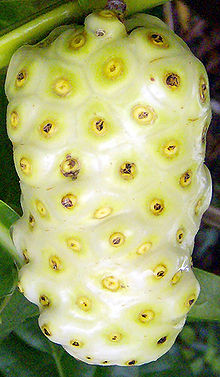-
(건강) Morinda citrifolia (노니)아름다운 인생/건강 2016. 6. 14. 11:24
출처: https://en.wikipedia.org/wiki/Morinda_citrifolia
From Wikipedia, the free encyclopedia"Noni" redirects here. For other uses, see Noni (disambiguation).Morinda citrifolia 
Leaves and fruit Scientific classification Kingdom: Plantae (unranked): Angiosperms (unranked): Eudicots (unranked): Asterids Order: Gentianales Family: Rubiaceae Genus: Morinda Species: M. citrifolia Binomial name Morinda citrifolia
L.Morinda citrifolia is a tree in the coffee family, Rubiaceae. Its native range extends through Southeast Asia and Australasia, and the species is now cultivated throughout the tropics and widely naturalised.[1]
English common names include great morinda,[2] Indian mulberry,[3] noni,[2] beach mulberry, and cheese fruit.[2]
Contents
[hide]Growing habitats[edit]
M. citrifolia, also called "noni" grows in shady forests, as well as on open rocky or sandy shores. It reaches maturity in about 18 months, then yields between 4 and 8 kg (8.8 and 17.6 lb) of fruit every month throughout the year. It is tolerant of saline soils, drought conditions, and secondary soils. It is therefore found in a wide variety of habitats: volcanic terrains, lava-strewn coasts, and clearings or limestone outcrops, as well as in coralline atolls.[4] It can grow up to 9 m (30 ft) tall, and has large, simple, dark green, shiny and deeply veined leaves.
The plant bears flowers and fruits all year round. The fruit is a multiple fruit that has a pungent odour when ripening, and is hence also known as cheese fruit or even vomit fruit. It is oval in shape and reaches 10–18 centimetres (3.9–7.1 in) size. At first green, the fruit turns yellow then almost white as it ripens. It contains many seeds. It is sometimes called starvation fruit. Despite its strong smell and bitter taste, the fruit is nevertheless eaten as a famine food[5] and, in somePacific islands, even a staple food, either raw or cooked.[6] Southeast Asians and Australian Aborigines consume the fruit raw with salt[7] or cook it with curry. The seeds are edible when roasted.
M. citrifolia is especially attractive to weaver ants, which make nests from the leaves of the tree. These ants protect the plant from some plant-parasitic insects. The smell of the fruit also attracts fruit bats, which aid in dispersing the seeds. A type of fruit fly, Drosophila sechellia, feeds exclusively on these fruits.[8]
Nutrients and phytochemicals[edit]
M. citrifolia fruit powder contains carbohydrates and dietary fibre in moderate amounts.[9] These macronutrients evidently reside in the fruit pulp, as M. citrifolia juice has sparse nutrient content.[10] The main micronutrients of M. citrifolia pulp powder include vitamin C,niacin (vitamin B3), iron and potassium.[9] Vitamin A, calcium and sodium are present in moderate amounts. When M. citrifolia juice alone is analyzed and compared to pulp powder, only vitamin C is retained[10] in an amount that is about half the content of a rawnavel orange.[11] Sodium levels in M. citrifolia juice (about 3% of Dietary Reference Intake, DRI)[9] are high compared to an orange, and potassium content is moderate. The juice is otherwise similar in micronutrient content to a raw orange.[11]
M. citrifolia fruit contains a number of phytochemicals, including lignans, oligo- and polysaccharides, flavonoids, iridoids, fatty acids,scopoletin, catechin, beta-sitosterol, damnacanthal, and alkaloids. Although these substances have been studied for bioactivity, current research is insufficient to conclude anything about their effects on human health.[12][13][14][15][16] These phytochemicals are not unique to M. citrifolia, as they exist in various plants.
Gastronomic uses[edit]
In Thai cuisine, the leaves (known as bai-yo, ใบยอ) are used as a green vegetable and the fruit (luk-yo, ลูกยอ) is added as a salad ingredient to some versions of somtam.
Traditional medicine[edit]
There are modern, unconfirmed, claims that green fruit, leaves, and root/rhizomes might have been used in Polynesian cultures as a general tonic, in addition to its traditional place in Polynesian culture as a famine food.[17]
In Traditional Chinese Medicine, the roots, known as Ba Ji Tian, have been used to treat abdominal pain, impotence, and menstrualdisorders.[18] Although Morinda is considered to have biological properties in traditional medicine, there is no confirmed evidence of clinical efficacy for any intended use.[19]
Consumer uses[edit]
Morinda bark produces a brownish-purplish dye that may be used for making batik. In Hawaii, yellowish dye is extracted from its roots to dye cloth.[20]
There have been recent applications for the use of M. citrifolia seed oil[21] which contains linoleic acid, possibly useful when applied topically to skin, e.g., for anti-inflammation, acne reduction, or moisture retention.[22][23][24]
See also[edit]
- Morinda
- Plant dyes
- Tropical fruit
- Flora of Queensland
- Flora of the Maldives
- Bushfood
- Plants described in 1753
'아름다운 인생 > 건강' 카테고리의 다른 글
(건강) 만연된 비만혐오 영양저조 문제 초래 (0) 2016.06.17 (건강) 최신연구결과, 새 치료법으로 다발성 경화증 잡을 수 있다 (0) 2016.06.14 (건강) 열대과일 노니 (0) 2016.06.14 (건강) 혈액암 중 하나는 질병 한개가 아닌 열한개를 달고 있다 (0) 2016.06.13 (건강) 열대 과일 가시여지 (0) 2016.06.13



